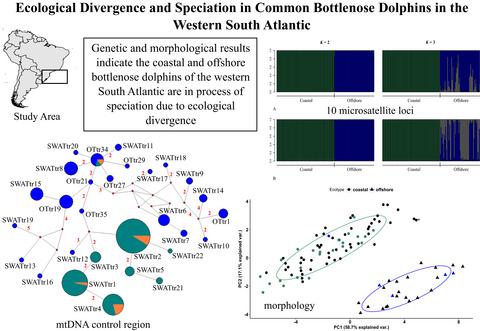当前位置:
X-MOL 学术
›
J. Evol. Biol.
›
论文详情
Our official English website, www.x-mol.net, welcomes your feedback! (Note: you will need to create a separate account there.)
Ecological Divergence and Speciation in Common Bottlenose Dolphins in the Western South Atlantic
Journal of Evolutionary Biology ( IF 2.1 ) Pub Date : 2019-12-27 , DOI: 10.1111/jeb.13575 Ana P B Costa 1 , Pedro F Fruet 2, 3, 4, 5 , Eduardo R Secchi 3 , Fábio G Daura-Jorge 6 , Paulo C Simões-Lopes 6 , Juliana C Di Tullio 2, 3, 4 , Patricia E Rosel 7
Journal of Evolutionary Biology ( IF 2.1 ) Pub Date : 2019-12-27 , DOI: 10.1111/jeb.13575 Ana P B Costa 1 , Pedro F Fruet 2, 3, 4, 5 , Eduardo R Secchi 3 , Fábio G Daura-Jorge 6 , Paulo C Simões-Lopes 6 , Juliana C Di Tullio 2, 3, 4 , Patricia E Rosel 7
Affiliation

|
Coastal and offshore ecotypes of common bottlenose dolphins have been recognized in the western South Atlantic, and it is possible that trophic niche divergence associated with social interactions is leading them to genetic and phenotypic differentiation. The significant morphological differentiation observed between these ecotypes suggests they represent two different subspecies. However, there is still a need to investigate whether there is congruence between morphological and genetic data to rule out the possibility of ecophenotypic variation accompanied by gene flow. Mitochondrial DNA (mtDNA) control region sequence data and 10 microsatellite loci collected from stranded and biopsied dolphins sampled in coastal and offshore waters of Brazil as well as 106 skulls for morphological analyses were used to determine whether the morphological differentiation was supported by genetic differentiation. There was congruence among the data sets, reinforcing the presence of two distinct ecotypes. The divergence may be relatively recent, however, given the moderate values of mtDNA nucleotide divergence (dA = 0.008), presence of one shared mtDNA haplotype and possibly low levels of gene flow (around 1% of migrants per generation). Results suggest the ecotypes may be in the process of speciation and reinforce they are best described as two different subspecies until the degree of nuclear genetic divergence is thoroughly evaluated: Tursiops truncatus gephyreus (coastal ecotype) and T. t. truncatus (offshore ecotype). The endemic distribution of T. t. gephyreus in the western South Atlantic and number of anthropogenic threats in the area reinforces the importance of protecting this ecotype and its habitat.
中文翻译:

南大西洋西部普通宽吻海豚的生态差异和物种形成
常见宽吻海豚的沿海和近海生态型已在南大西洋西部得到确认,与社会互动相关的营养生态位差异可能导致它们发生遗传和表型分化。在这些生态型之间观察到的显着形态差异表明它们代表了两个不同的亚种。然而,仍然需要调查形态学和遗传数据之间是否存在一致性,以排除伴随基因流动的生态表型变异的可能性。线粒体 DNA (mtDNA) 控制区域序列数据和 10 个微卫星位点从在巴西沿海和近海水域取样的搁浅和活检海豚以及 106 个用于形态分析的头骨中收集,用于确定形态分化是否受遗传分化的支持。数据集之间存在一致性,加强了两种不同生态型的存在。然而,考虑到 mtDNA 核苷酸差异的适中值 (dA = 0.008)、一个共享的 mtDNA 单倍型的存在以及可能的低水平基因流(每代移民的 1% 左右),这种差异可能相对较新。结果表明,生态型可能处于物种形成过程中,并且在彻底评估核遗传差异程度之前最好将它们描述为两个不同的亚种:Tursiops truncatus gephyreus(沿海生态型)和 T. t. truncatus(近海生态型)。T. t. 的地方性分布 南大西洋西部的 gephyreus 和该地区人为威胁的数量加强了保护这种生态型及其栖息地的重要性。
更新日期:2019-12-27
中文翻译:

南大西洋西部普通宽吻海豚的生态差异和物种形成
常见宽吻海豚的沿海和近海生态型已在南大西洋西部得到确认,与社会互动相关的营养生态位差异可能导致它们发生遗传和表型分化。在这些生态型之间观察到的显着形态差异表明它们代表了两个不同的亚种。然而,仍然需要调查形态学和遗传数据之间是否存在一致性,以排除伴随基因流动的生态表型变异的可能性。线粒体 DNA (mtDNA) 控制区域序列数据和 10 个微卫星位点从在巴西沿海和近海水域取样的搁浅和活检海豚以及 106 个用于形态分析的头骨中收集,用于确定形态分化是否受遗传分化的支持。数据集之间存在一致性,加强了两种不同生态型的存在。然而,考虑到 mtDNA 核苷酸差异的适中值 (dA = 0.008)、一个共享的 mtDNA 单倍型的存在以及可能的低水平基因流(每代移民的 1% 左右),这种差异可能相对较新。结果表明,生态型可能处于物种形成过程中,并且在彻底评估核遗传差异程度之前最好将它们描述为两个不同的亚种:Tursiops truncatus gephyreus(沿海生态型)和 T. t. truncatus(近海生态型)。T. t. 的地方性分布 南大西洋西部的 gephyreus 和该地区人为威胁的数量加强了保护这种生态型及其栖息地的重要性。


























 京公网安备 11010802027423号
京公网安备 11010802027423号